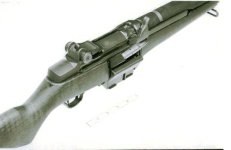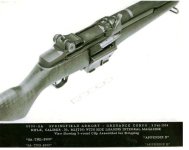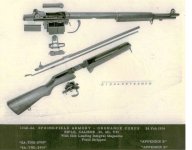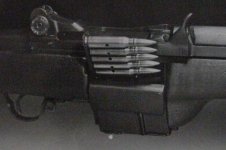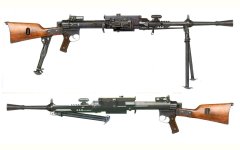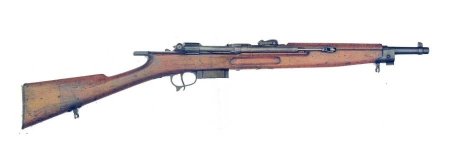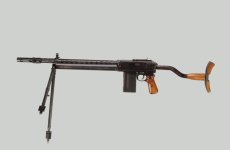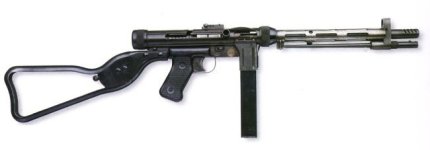Ulrice,,, good one

35 Breda Modello 30 Light Machine Gun
https://en.wikipedia.org/wiki/Breda_30
The Fucile Mitragliatore Breda modello 30 was the standard light machine gun of the Royal Italian Army during World War II.
The Breda 30 was rather unusual for a light machine gun. It was fed from a fixed magazine attached to the right side of the weapon and was loaded using brass or steel 20-round stripper clips. If the magazine or its hinge/latch were damaged the weapon became unusable. It also fired from a closed bolt along with using blowback for its action. The blowback operation was violent, and often resulted in poor primary extraction. During primary extraction, the initial very small rearward movement of the hot expanded cartridge case away from the chamber's walls must be powerful but very slow, if an automatic weapon is to be reliable. Separated cases resulting in jamming of the weapon beyond field clearing, were usually the consequence of poor primary extraction. Breda 30 also inherently lacked good primary extraction in its design and thus utilized a small lubrication device that oiled each cartridge as it entered the chamber. With the dust and sand of the deserts of North Africa, came a combination of premature wear and jamming.
As an automatic weapon's chamber and barrel heat up with prolonged automatic fire, the resulting excessive temperature can cause a chambered round to cook off or ignite without intent of the gunner. As a result of firing from a closed bolt, the Breda 30 could not fully take advantage of the cooling properties of air circulation like an open bolt weapon would, thus making cooked off rounds a realistic hazard. The disastrous results could lead to potential injuries to or even the death of the gunner. Some Bredas were eventually modified to accept the new 7.35 mm cartridge, which the Italian military was making an effort to adopt; however, this was short-lived as slowed production never fully allowed adoption of the new cartridge.
In regular Army units, one Breda 30 was issued to each squad (standard issue was 24 to 27 per battalion), although this was later changed to two weapons per squad; an Italian infantry company therefore had about six light machine guns in the early years of World War II (two per platoon), but this number eventually ballooned to twelve for the majority of the war (four per platoon).
An infantry platoon was divided into two large sections, each of twenty men, which were further split into rifle and light machine gun squads. The section was commanded by a Sergeant, who also controlled the LMG squad. The latter was made up of two Breda 30s, each manned by a Corporal gunner, an assistant gunner and two ammunition bearers. The balance of the section was found in the rifle squad of eleven men. Due to the importance of its extra firepower, the Breda 30 was most often given to the squad's most reliable soldier (unlike other armies of the time, it was not rare to see an NCO brandishing himself the squad's automatic weapon). The manual indicates that the two squads were to operate as distinct elements, with the two LMGs supporting the Rifle squad onto its objective. At the time, most other armies embedded a light machine gun with each Section/Squad, themselves roughly half the size of the Italian Squad, which by comparison seems an unwieldy organisation. Individual weapons are given as pistols for each Corporal gunner, a carbine for the Major Sergeant and rifles for all others.
The Wehrmacht adopted the Breda 30 in small numbers after the occupation of Northern and Central Italy, after the Italian armistice of 1943, using the nomenclature MG 099(i); it filled a similar role as the German MG 34, a light machine gun, predominantly utilized in the Italian Campaign battlefields.
Although distinctive in appearance, the Breda 30 was widely viewed as a poorly designed weapon. It had a low rate of fire, low magazine capacity, used the underpowered and unreliable 6.5×52mm cartridge and was highly prone to stoppages. The vital oiling system quickly picked up dust and debris, making the weapon unreliable in combat conditions.
The Breda's rear and fore sight were both on the gun body, so only one barrel could be zeroed. The magazine was loaded using 20-round stripper clips, which were known to be fragile, especially in combat conditions. In North Africa the weapon was nearly unusable: desert sand and dust caused the weapon to jam continuously. The oil from the lubrication necessary to fire the Breda exacerbated its flaws. In the Balkans, Russian Campaign and other theatres of war the weapon achieved slightly better results.
Low magazine capacity, frequent jamming and the complicated barrel-change made firing and reloading a slow and laborious process, resulting in the Breda 30 being a weapon only capable of laying down a diminutive amount of firepower and making it a very modest contributor to a firefight. When considering all of the gun's deficiencies, taken during combat when it was at its worst, the practical rate of fire of the Breda 30 could even have been comparable to a semi-automatic weapon's practical rate of fire, as the standard American rifle was (the M1 Garand).
Although considerably flawed when compared to its contemporaries, the Breda 30 was still considered the deadliest weapon of the standard Italian infantryman's arsenal, since heavy machine guns were seen in relatively small numbers and submachine guns were very rare. The Breda 30 along with the Carcano M91 rifle made up the backbone of the Italian infantry armament during the Second World War. Field reports on the weapon were of mixed nature: the Breda's very low rate of fire often resulted in a turning of the tide during a firefight against Italian soldiers; however, the Breda 30, in most occasions, was the fastest and most helpful weapon available. The Italian army attempted to counter the Breda's defects by stressing the importance of the loader's role: every soldier was trained to eventually be a Breda 30 loader and taught how to rapidly feed one ammunition strip after another (this was not always possible, as with Breda 30s mounted on motorcycles). Careful polishing was also carried out frequently with extra attention being paid to Breda's lubrication system and ammunition availability.

